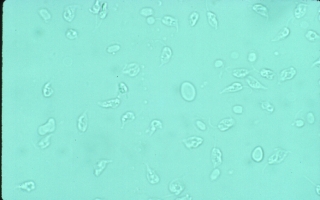 Ichthyobodo
sp.
Ichthyobodo
sp.
 Ichthyobodo
sp.
Ichthyobodo
sp.
Ichthyobodo sp. (also known as Costia) is a tiny tear drop shaped flagellated ectoparasite. This organism is difficult to see because of its small size. It may be found attached to gill or skin cells by its narrow end or moving in a jerky circular motion in the wet-mount fluid near the tissue. This parasite is small about 0.007mm and is about the size of the red blood cells.
Ichthyobodo sp. infestation have been often found associated with mortality of fry and juvenile tilapia cultured in Hawaii. The organism or closely related organisms have been recognized on tilapia in both fresh and saltwater. Ichthyobodo sp. seems to multiply rapidly and has a direct life cycle. The organism is an obligate parasite of fish although the agent may be quite specific for particular fish host species. Ichthyobodo sp. apparently feeds on cells on the skin and gill surfaces causing great irritation. This results in excessive mucus excretion and, when infections are prolonged, proliferation or hyperplasia of the surrounding cells. Tilapia dying of Ichthyobodo sp. infestation have signs of respiratory distress and may have a slight, whitish film of mucus on areas of the body.
Diagnosis of Ichthyobodo sp. infection is my microscopic demonstration of the parasite in wet-mounts of affected gill or skin scrapings. Further information on the appearance of Ichthyobodo sp. is available in the Microscopic Examination option of the Solve a Problem Section of this program.
Ichthyobodo sp. disease can be treated effectively with the commonly used chemicals for fish ectoparasite control. However, these chemicals have not received approval by the FDA for use with tilapia. Proceed to the Treatment Section of the program for additional information.